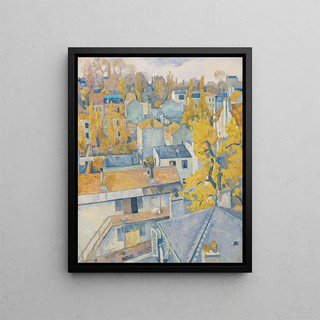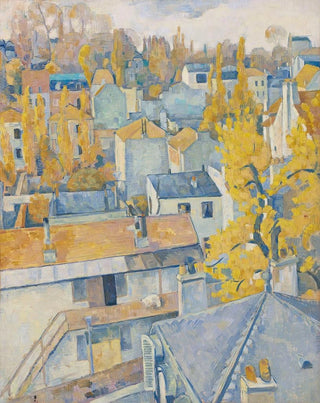Art print | View of the rooftops - Émile Bernard


View from behind

Frame (optional)
In the vast panorama of art history, certain works stand out for their ability to capture the essence of a moment, an atmosphere. "Vue des toits - Émile Bernard" is a perfect example. This artwork invites the viewer to immerse themselves in a universe where light and shapes meet harmoniously. Through this painting, Bernard offers us a poetic vision of the rooftops, an urban landscape that, far from being a simple representation, evokes deep emotions and prompts reflection on city life. Every brushstroke seems to breathe a story, a memory, bearing witness to a time and place that still resonate today.
Style and uniqueness of the work
Émile Bernard's style is characterized by an innovative approach that combines Impressionism and Symbolism. In "Vue des toits," he deploys a palette of delicate colors, where shades of blue and gray blend subtly, creating an atmosphere that is both serene and melancholic. The geometric shapes of the rooftops, stylized and simplified, reflect his desire to transcend reality to offer a more personal interpretation. The artwork is distinguished by a balanced composition, where each element finds its place in a harmonious visual dialogue. This ability to transform everyday life into a unique aesthetic experience is what gives this painting its singularity and emotional impact.
The artist and his influence
Émile Bernard, an emblematic figure of the Post-Impressionist movement, made his mark through his boldness and originality. By moving away from established conventions, he paved the way for new artistic explorations. His interaction with other great masters, such as Paul Gauguin, enriched his style and allowed him to refine his vision. Bernard also played a crucial role in spreading Symbolist ideas, seeking to express deep feelings and abstract ideas through his works. His influence endures, inspiring many contemporary artists who see in him a pioneer of a new way of approaching painting. "Vue des toits" is not just a painting; it is a testament to this quest for innovation and personal expression that defines his career.

Matte finish

View from behind

Frame (optional)
In the vast panorama of art history, certain works stand out for their ability to capture the essence of a moment, an atmosphere. "Vue des toits - Émile Bernard" is a perfect example. This artwork invites the viewer to immerse themselves in a universe where light and shapes meet harmoniously. Through this painting, Bernard offers us a poetic vision of the rooftops, an urban landscape that, far from being a simple representation, evokes deep emotions and prompts reflection on city life. Every brushstroke seems to breathe a story, a memory, bearing witness to a time and place that still resonate today.
Style and uniqueness of the work
Émile Bernard's style is characterized by an innovative approach that combines Impressionism and Symbolism. In "Vue des toits," he deploys a palette of delicate colors, where shades of blue and gray blend subtly, creating an atmosphere that is both serene and melancholic. The geometric shapes of the rooftops, stylized and simplified, reflect his desire to transcend reality to offer a more personal interpretation. The artwork is distinguished by a balanced composition, where each element finds its place in a harmonious visual dialogue. This ability to transform everyday life into a unique aesthetic experience is what gives this painting its singularity and emotional impact.
The artist and his influence
Émile Bernard, an emblematic figure of the Post-Impressionist movement, made his mark through his boldness and originality. By moving away from established conventions, he paved the way for new artistic explorations. His interaction with other great masters, such as Paul Gauguin, enriched his style and allowed him to refine his vision. Bernard also played a crucial role in spreading Symbolist ideas, seeking to express deep feelings and abstract ideas through his works. His influence endures, inspiring many contemporary artists who see in him a pioneer of a new way of approaching painting. "Vue des toits" is not just a painting; it is a testament to this quest for innovation and personal expression that defines his career.






